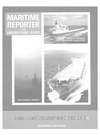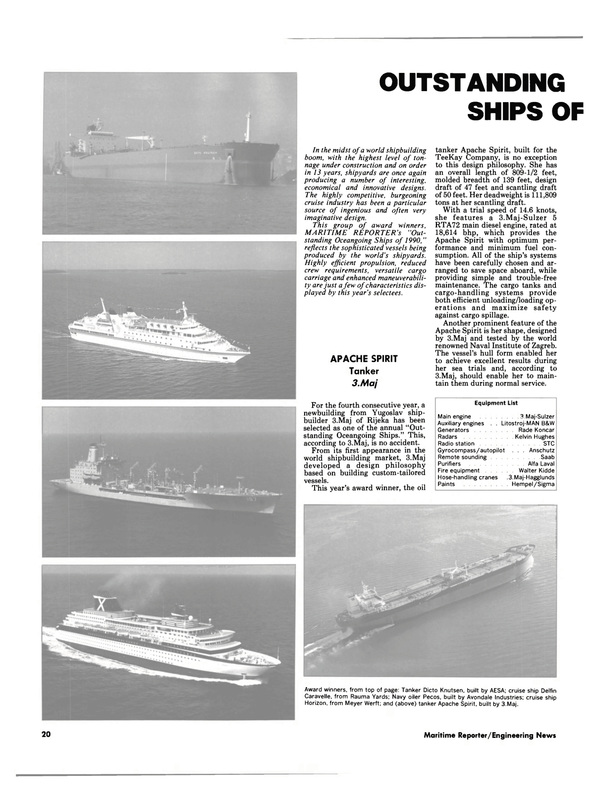
Survey Reveals Recovery Of Small- And Medium-Sized Yards
The American Waterways Shipyard Conference (AWSC), a conference within The American Waterways Operators, represents the interests of the small- and mediumsized or "second-tier" yards in the shipbuilding and repair industry.
These yards build and repair the tugboats, towboats and barges for the domestic water transportation industry; the supply boats, crewboats, and other specialized vessels for the offshore service industry; and a wide variety of fishing vessels.
They are also typically responsible for the construction and repair of the Navy's smaller vessels, the Coast Guard fleet, and vessels operated by the Army Corps of Engineers and NOAA.
In order to develop an accurate statistical profile of the industry, which can be utilized to identify trends for use in legislative and regulatory issues which affect secondtier shipyards, this survey has been conducted under the auspices of the Economic and Commercial Committee of the American Waterways Shipyard Conference.
Information on employment, new construction, and repair activities for this survey were compiled on a voluntary basis from approximately 250 second-tier shipyard facilities, and includes data from the years 1980 to 1989. The American Waterways Shipyard Conference is the only association which collects this type of information for the second tier of the shipbuilding industry.
Employment Trends The "Employment Information and Trends" section of the survey contains information on activities directly related to employment in the shipyard facility.
The surveyed group contains a majority of the major employers found within the second tier commercial shipbuilding industry.
Table 1, "Employment Levels in Second Tier Shipyards, 1980-1989," shows the number of employees for each given year for the statistical pool. Employment levels peaked in 1981 at 24,699 and had declined by 54 percent to a low of 11,393 in 1984.
That was the last year to show a decrease in employment. Since 1984, employment has gradually increased each year until dropping again in 1988 to a level of 11,424.
Then, in 1989, there was a 15 percent increase in employment.
Graph 1, "Employment Levels, 1980-1989," visually depicts the employment situation for the secondtier shipyards. This graph illustrates the rapid decrease in employment levels for the smaller shipyard facilities from 1981 to 1984, stabilization of employment levels from 1985 to 1988, and growth from 1988 to 1989.
New Construction and Repair In 1989, ninety-four percent of all respondents provided information on new construction and repair activities.
Of all the respondents, 86 percent reported having done repair work, while 53 percent of the respondents said that they had worked on new construction projects in 1989. Six percent of the respondents advised that they had not done either repair or new construction work in 1989.
Tables 6 and 7 contain information generated on new construction and repair activities for the years 1980 to 1989. Tables 6 and 7 further substantiate evidence of the recovery being experienced by small- and medium-sized shipyards. Between 1988 and 1989, there was a 70 percent decrease in the number of power- driven vessels constructed. Most of the decrease, however, was in the category of military vessels; 417 built in 1988 and 39 built in 1989.
There was a 53 percent increase in the construction of river barges.
Most of this increase was in the category of hopper barges; 217 built in 1988 and 484 built in 1989. Another factor in this growth of new construction is the construction of offshore barges; two built in 1988 and 29 built in 1989.
Increases in repair activity were substantial with repair of river barges actually increasing 33 percent.
In this category of power-driven vessels there was a 7 percent decrease, while there was a 5 percent increase in the repair of off- shore barges.
Graphs 2, 3 and 4 visually depict new construction activities for the second-tier shipyards for the years 1980 to 1989. The graphs are divided by vessel category—Power Driven Vessels (Graph 2), River Barges (Graph 3), and Offshore Barges (Graph 4). Each graph represents the new construction activities for all specific types of vessels which fall under each general category.
Read Survey Reveals Recovery Of Small- And Medium-Sized Yards in Pdf, Flash or Html5 edition of December 1990 Maritime Reporter
Other stories from December 1990 issue
Content
- Hvide Takes Delivery Of Reconstructed Chemical Tanker page: 6
- Wartsila Diesel Introduces In-Line Version Of Nohab 25 Engine page: 6
- Willi Becker Rudder Installed On Converted ' M / V Seabulk America' page: 7
- Norway Export Award Goes To Peter Lombard page: 7
- Major EC Yards Outline 'Eurotanker' Development page: 8
- MSI/CAORF Offers Safety Course In Tug/Barge Handling page: 8
- Diversified Technologies Supplies Launch/Retrieval System For Steam Tanker page: 9
- Gladding-Hearn Building N.Y. City Harbor Survey Boat page: 10
- NKK To Build First LNG Carrier To Use Technigaz Mark III Membrane-Type Cargo Tank System page: 11
- Balehi Marine Delivers 1,800-HP Towboat 'Lake Charles' To Conoco Oil Company page: 11
- Sea-Land To Repower Huge Containerships With MAN B&W Gensets page: 12
- NEI Syncrolift Receives Orders For Five New Lifts For Three Continents page: 13
- Trinity Marine To Develop Process To Construct Double-Hull Tankers page: 13
- Meyer Werft Delivers Third In Series Of Six Gas Carriers For USSR page: 13
- MARCO Receives Order For Oil Spill Recovery Boat; Completes Trawler Lengthening page: 14
- San Carlos Factory Offers Wide Range Of Marine Boilers And Equipment page: 15
- European Yards Look To 'Formula' To Compete With Their Far East Counterparts page: 16
- Are American Shipyards Competitive? page: 17
- Survey Reveals Recovery Of Small- And Medium-Sized Yards page: 18
- New Tugboat Is First In Delaware Waters In Over 50 Years page: 19
- Comsat Introduces New SeaMail® Electronic Service page: 19
- OUTSTANDING OCEANGOING SHIPS OF 1990 page: 20
- $1.3 BILLION AVAILABLE TO INITIATE SEALIFT SHIP CONSTRUCTION PROGRAM page: 27
- Cost Of Naval Operations In Persian Gulf Region Continues To Escalate page: 32
- Ingalls Shipbuilding Christens Aegis Cruiser Anzio—15th Of 19 Being Built For U.S. Navy page: 34
- Cruise + Ferry 91 Set For May 29-31 In London page: 41
- 1991 Ship Production Symposium, San Diego, September 4-6, 1991, Issues Call For Papers page: 42
- Hitachi Zosen Completes 275,993-Dwt Tanker Sea Duke page: 42
- Congressional Leaders Take Hard Line On Foreign Shipbuilding Subsidies page: 43
- Trinity Marine Wins $9-Million Contract To Build Matson Barge page: 43
- 4,000-HP Tug Delivered By Main Iron Works To Coastal Tug & Barge page: 45
- Hitachi Zosen Selects Argo Marine As U.S. Agent For Engine Parts Sales page: 47
- Three Quays Sign Agreement For Ultramar Newbuildings page: 47
- Hull Electronics Announces New Linear Amplifiers page: 48
- Deere Commercial Marine Engine Marketing Plans On Stream For Early 1991 page: 48
- Homeport Marine Services Completes Rework Project On 180-Foot 'Ebb Tide II' page: 50
- Onan Introduces Sea Aux® Gensets page: 50


